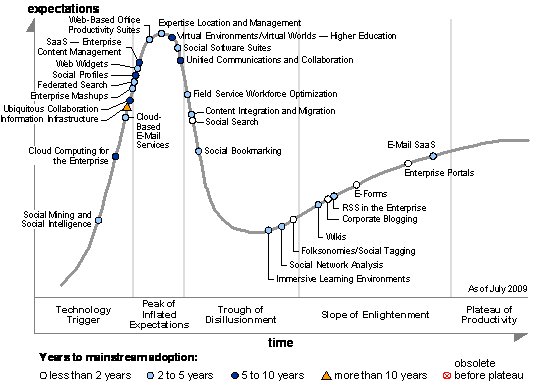First, enterprise portals will have a business transformational effect in less than two years.
"Portals remain one of the most highly sought-after interfaces across Fortune 2000 organisations and have reached the mainstream," said David Gootzit, research director at Gartner. "They are fundamental technical components of the high-performance workplace, whether as replacements for first-generation intranets, the cornerstone of knowledge management initiatives, or as B2E portals that serve as the primary way for employees to access and interact with back-end systems and content repositories."
In the next five to 10 years, Gartner predicts that cloud computing for the enterprise and unified communications and collaboration will have a transformational business impact.
"Cloud computing will see a varied adoption pattern in the organisation and some things must be addressed before organisations will feel safe in using cloud computing services," said Gene Phifer, managing vice president at Gartner.
At this time, Type A organisations (organisations that are technologically aggressive and well-funded and are willing to adopt leading-edge technology to gain a competitive advantage) are the predominant users of cloud computing because the risk/reward equation for various cloud services is unacceptable for many Type Bs (organisations that have adequate IT funding, and typically adopt technologies once they have entered the mainstream) and all Type Cs (organisations that are technologically conservative and risk-averse. They place a premium on controlling IT costs, and are typically among the last to adopt new technologies). As the technologies and vendors of cloud computing mature, broader sets of organisations will take the plunge.
Adoption of the cloud will accelerate in 2010, with small businesses and organisations in developing nations taking great advantage of cloud-based services. Large organisations will adopt the cloud at different paces, depending on their risk profiles, but even Type B organisations will start to take significant advantage of the cloud starting in 2011 and 2012.
Although unified communications and collaboration (UCC) is newer and less developed than unified communications (UC), it has the potential to go much further toward realising transformational changes. Also at the peak of the hype cycle sit social software suites which will have a high impact in the next two to five years, according to Gartner. The industry is starting to move from general-purpose suites to more targeted products, focusing on "horizontal" social business challenges, such as idea engines and prediction markets.
UCC is the juncture where the market for communications overlaps with the collaboration market. It straddles both areas of communications and collaboration technologies to include e-mail, audio/web/videoconferencing, instant messaging (IM), and voice over IP (VoIP) and so on.
"Organisations will realise its value in several ways," said Jeffrey Mann, research vice president at Gartner. First will be the simplified and more effective use of the increasingly broad range of collaboration and communication options. Second will be the improved ability of individuals and groups to accelerate reactions to market events. Third will be the efficiency gains via the contextual embedding of communication services into applications at points where, for example, process disconnections occur and human intervention is necessary.
Source: Gartner (July 2009)
If you would like to discuss in more detail the findings of this hype cycle, please contact Laurence Goasduff on + 44 (1784) 267 195 or at laurence.goasduff@gartner.com. The technologies mentioned above will be further examined at Gartner PCC Summit 2009, 16-17 September, London. For further information please visit www.europe.gartner.com/pcc
The high performance workplace hype cycle is part of "Gartner's Hype Cycle Special Report for 2009." It evaluates the maturity of 1,650 technologies and trends in 79 technology, topic and industry areas.


